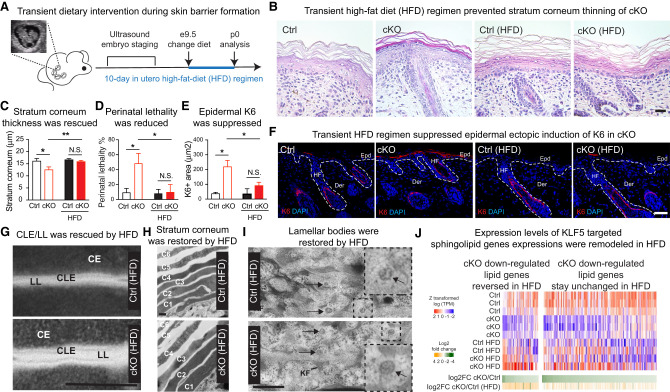Figure 6.
Epidermal deficiency from KLF5 ablation can be rescued by transient lipid-rich dietary interventions. (A) Schematics show transient dietary intervention regimen. A pregnant dam was subjected to embryonic staging via ultrasound every 2–3 d once breeding started and until E9.5 was identified, at which point the female was switched to a high-fat diet. Ten days later, pups were born and analyzed. (B,C) Hematoxylin and eosin staining and quantification of postnatal day 0 skin sections from high-fat diet (HFD) demonstrating that there were no longer significant (N.S.) differences between Ctrl and cKO mice with regard to the stratum corneum thickness (Ctrl: n = 12; cKO: n = 20). Scale bar, 60 μm. (D) There was no longer a significant difference observed in perinatal lethality of HFD-fed Ctrl and cKO mice (Ctrl: n = 15; cKO: n = 12). (E,F) IF of K6 and quantifications reveal no significant difference between HFD-fed Ctrl and cKO mice (Ctrl: n = 8; cKO: n = 6). Note the normal expression of K6 in the hair follicle (HF) companion lineage in both Ctrl and cKO sections. (Epd) Epidermis, (Der) dermis. Scale bar, 50 μm. For C–E, unpaired t-test was used. (*) P < 0.05, (**) P < 0.01. (G–I) Transmission electron microscopy (TEM) revealed restored cornified lipid envelope (CLE) and intercellular lipid lamellae (LL) bridging the cornified envelope (CE) (G), rescued cornified envelope organization (H), and largely normalized granular layer lamellar bodies (I) from HFD-fed cKO mice compared with Ctrl. Shown are uncropped images from 25,000× acquisition, and the epidermal angle observed in cKO was due to curvature during sample preparations. (CD) Corneodesmosome, (KG) keratohyalin granules, (KF) keratin filaments. Scale bars: G,H, 500 nm; I, 100 nm. (J) Heat map of RNA-seq data showing that expressions of some sphingolipid metabolism genes are reversed in dietary-rescued skin, while others remain unchanged.

